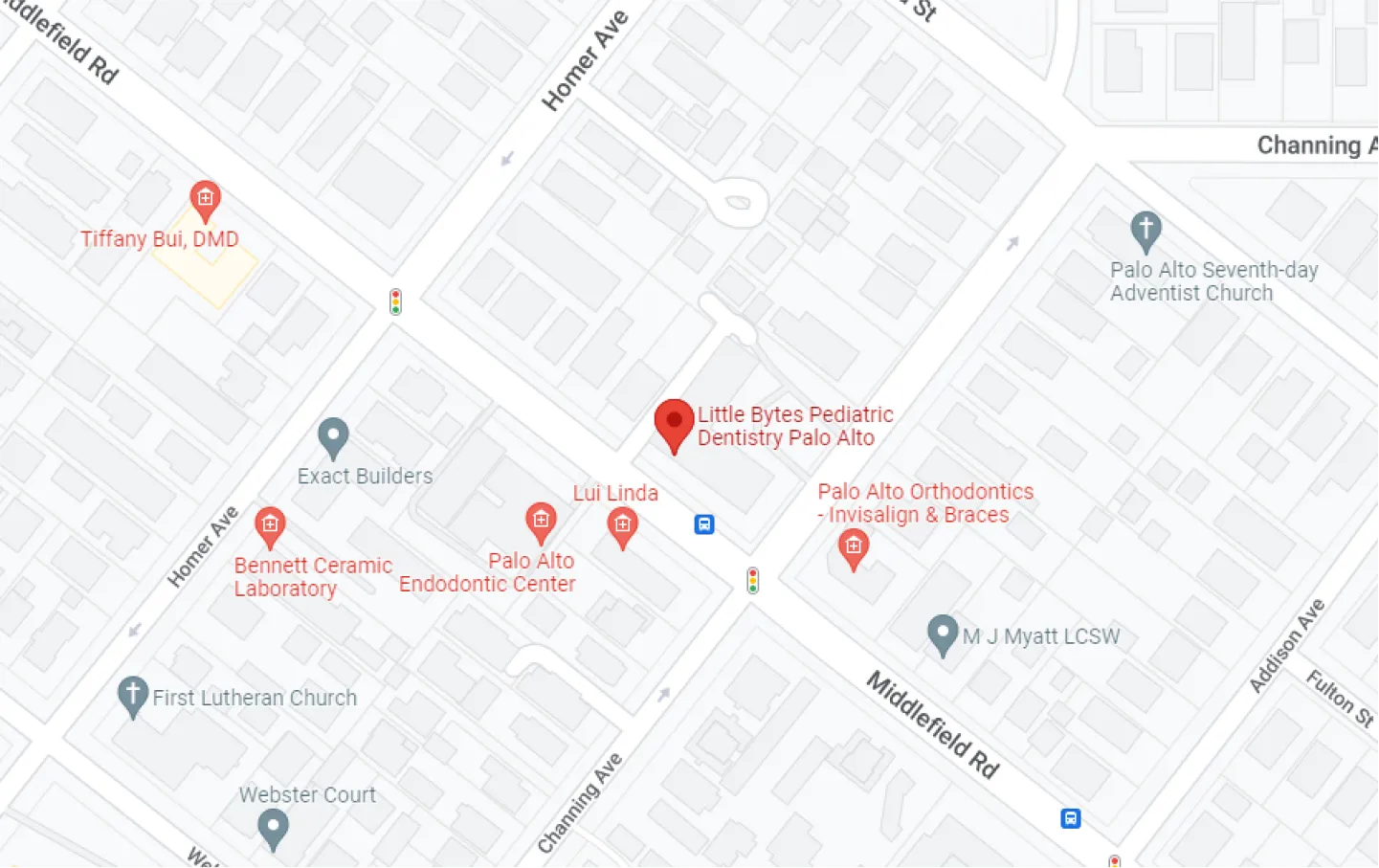




You take your child to a pediatrician to treat their health needs because of the specialized training they have received. A pediatric dentist has additional training to treat your child's oral health needs. Dr. Michelle and Dr. Grover have completed training after dental school that qualifies them to treat children.
Pediatric dentists are the pediatricians of dentistry. A pediatric dentist has two to three years of specialty training following dental school and limits their practice to treating children only. Pediatric dentists are primary and specialty oral care providers for infants and children through adolescence, including those with special health needs.
The sooner your child begins having regular dental checkups, the healthier their mouths will be. Early checkups detect and prevent tooth decay and cavities, which cause pain and other medical issues. When your child's teeth are healthy, they can chew their food easily, speak clearly, and have a confident smile.
The Academy of Pediatric Dentistry recommends that your child see a pediatric dentist when the first tooth appears, or no later than their first birthday in order to prevent dental problems.
Baby teeth are important to help children speak clearly and chew naturally. They also aid in forming a path permanent teeth can follow when they are ready to erupt.
You'll want to check a dentist’s qualifications and ensure they are certified by the American Board of Pediatric Dentistry. They should have adequate experience, local hospital privileges, and positive reviews. You'll want to know they provide a wide range of services to treat your child's dental concerns. For all of these qualifications and more, look no further than Little Bytes Pediatric Dentistry in Palo Alto.
Dr. Michelle and Dr. Grover are specially trained and ready to treat babies, children, and teenagers up to age 18.
Yes! We are accepting new patients and our doctors spend as much time as necessary to get to know and understand the needs of each patient.
The most important thing to do is to remain calm. Then find the tooth. Hold it by the crown rather than the root and put the tooth in a glass of milk and call us. We can accommodate urgent needs so you can bring your child and the tooth immediately in to see our pediatric dentist. For young children, do not place the tooth back in the socket as this could be a choking hazard.
Regular visits to the pediatric dentist help keep your child cavity free. Teeth cleanings remove buildup that is not easily removed by simple brushing and may irritate gums and cause decay. Fluoride treatments renew the content in the enamel and help strengthen your child’s teeth. Proper dental hygiene improves your child’s teeth and gums and overall health. More frequent visits may be recommended by Dr. Michelle or Dr. Grover based on your child’s personal oral health.
Teething, or the process of baby teeth coming through the gums and into the mouth, varies among babies. Generally, the lower anterior teeth are the first baby teeth to appear in the mouth between 6-8 months of age. There are some babies that are born with teeth, neonatal teeth, and some that begin teething after 12 months of age. The American Academy of Pediatric Dentistry recommends a child’s first dental visit before his/her first birthday.
A toothbrush will remove plaque bacteria that can lead to decay. Any soft-bristled toothbrush with a small head should be used twice a day in the morning and at bedtime.
The sooner the better! Starting at birth, clean your child’s gums with a soft infant toothbrush or cloth and water. Parents should use a tiny smear of fluoride toothpaste to brush baby teeth twice daily as soon as they erupt and a soft, age-appropriate sized toothbrush. Once children are 3 to 6 years old, the amount should be increased to a pea-sized dollop and you should continue to assist your child’s teeth brushing. Remember that young children do not have the ability to brush their teeth effectively. Children should spit out and not swallow excess toothpaste after brushing. There are many excellent kinds of toothpaste on the market today. Try different brands and flavors to see which ones your child likes the best. Check the ingredients of the toothpaste. Fluoride or xylitol can help to prevent cavities and should be used with adult supervision.
Dental X-rays are safe and pose very minimal risks. Preventative measures are used to minimize these risks with the use of a lead apron and digital radiography. We use state-of-the-art digital X-ray machines that have minimal exposure. In addition, we use monitors to gauge the exposure of radiation in our office.
The need for dental X-rays varies from child to child. Dental X-rays are used to survey erupting teeth, check for bone diseases, check for cavities, evaluate the results of an injury, or plan orthodontic treatment. Dentists use these X-rays to diagnose and treat conditions that cannot be detected by a clinical exam alone. The American Academy of Pediatric Dentistry recommends radiographic exams every 6 months on children at high risk of tooth decay. Children at low risk for dental decay will require X-rays less frequently.
At Little Bytes, we take your child’s health seriously. Fluoride is beneficial and safe in the right amount, applied both topically and in drinking water. We educate all parents on the risks and benefits of fluoride.
Sealants work by filling in the crevasses on the chewing surfaces of the teeth. This shuts out food particles that could get caught in the teeth, causing cavities. The application is fast and comfortable and can effectively protect teeth for many years. We use BPA-free plastic material to seal teeth.
A composite filling is a tooth-colored, BPA-free plastic material that is used to repair teeth. There are several reasons why composite fillings are needed:
Repair and fill cavities
Repair broken or fractured teeth
Repair chipped teeth
Adjust the size or shape of teeth
Change the color of the teeth or reshape disfigured teeth for cosmetic reasons
Composite fillings are part of
here at Little Bytes Pediatric Dentistry.A pulpotomy, or baby root canals, is performed if the cavity reaches the nerve of the tooth. In a pulpotomy, the portion of the nerve infected by the cavity is removed, the area is sterilized and sealed. The tooth is then covered by a dental crown to protect it from breaking or fracturing. A pulpotomy is usually done using a local anesthetic, but Dr. Michelle and Dr. Grover always take into consideration the individual child and their unique needs.
To help relieve your child’s toothache, thoroughly clean the area around the sore tooth. Then rinse the child’s mouth with warm salt water, or use dental floss to dislodge trapped food or debris. Apply a cold compress to reduce any swelling. Call us at Little Bytes to see Dr. Michelle or Dr. Grover as soon as possible.
Thumb and pacifier sucking habits will generally only become a problem if they go on for a very long period of time. Most children stop these habits on their own, but if they are still sucking their thumbs or fingers past the age of three, a mouth appliance may be recommended by your pediatric dentist.
.Make sure your child has a balanced diet, including one serving each of fruits and vegetables, bread and cereals, milk and dairy products, and meat, fish, and eggs. Limiting the servings of sugars and starches will also aid in protecting your child’s teeth from decay. You can also ask your pediatric dentist at Little Bytes to help you select foods that protect your children’s teeth.
Soft, plastic mouthguards can be used to protect a child’s teeth, lips, cheeks, and gums from sport-related injuries. A custom-fitted mouthguard developed by your pediatric dentist at Little Bytes will protect your child from injuries to the teeth, face and even provide protection from severe injuries to the head.
Get in Touch
Please complete and submit the form and a member of our staff will contact you shortly.


Little Bytes
Tuesday - Friday 9:00am - 5:00pm
Se Habla Español






